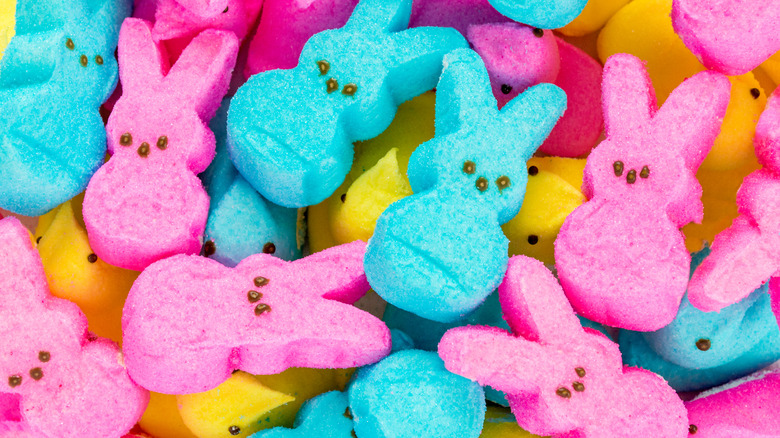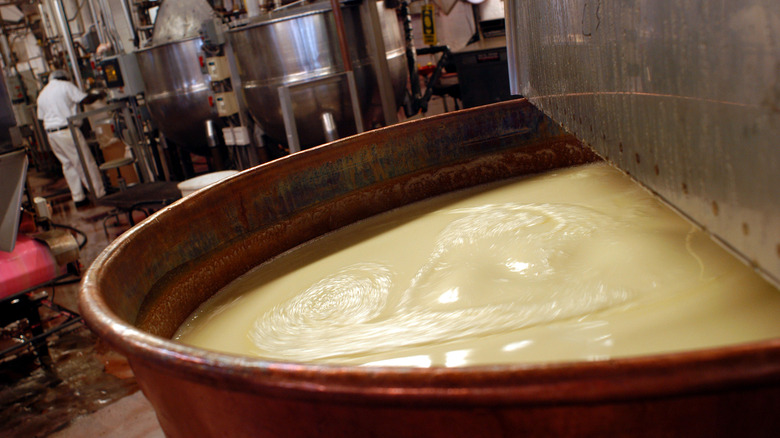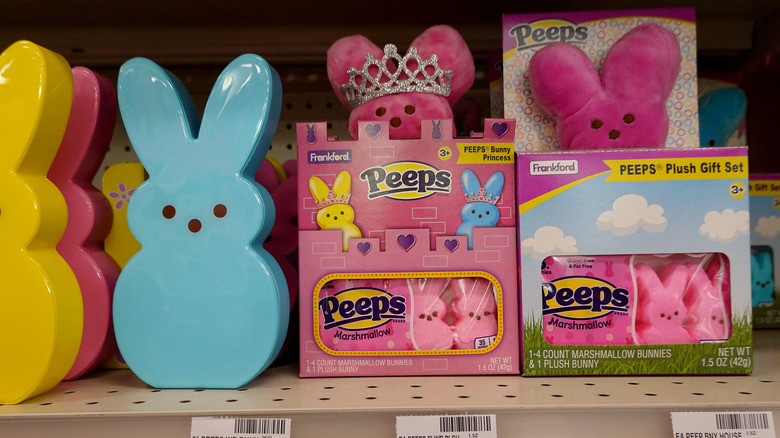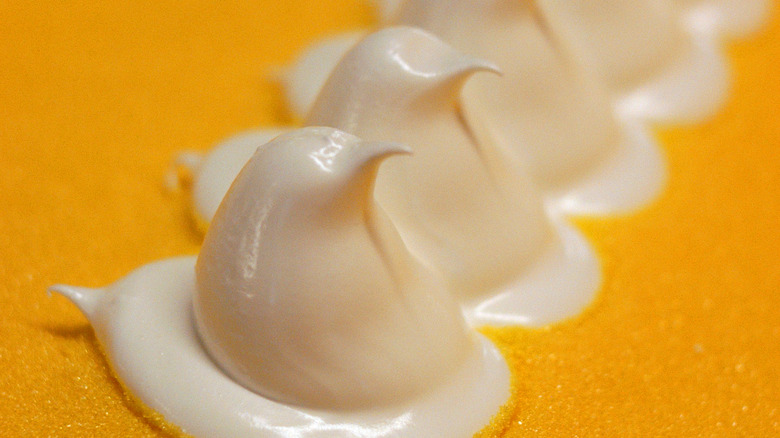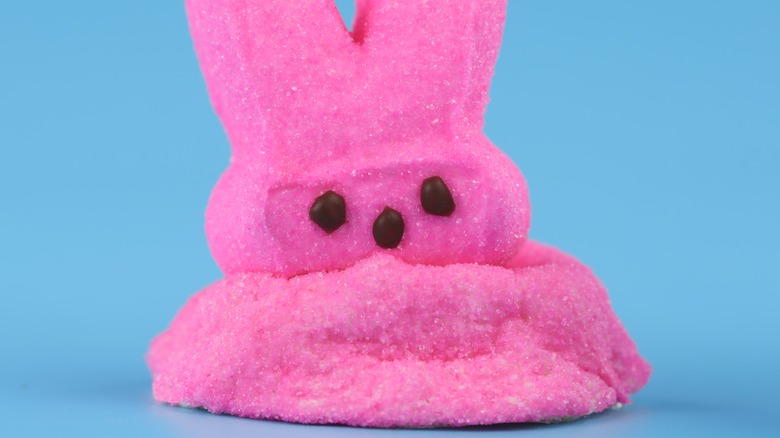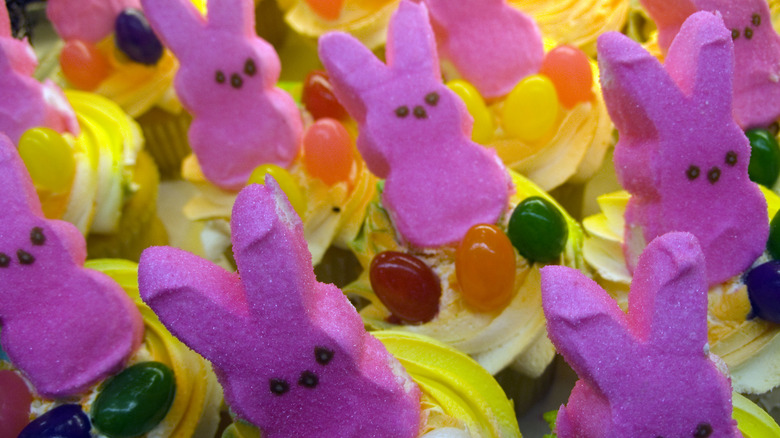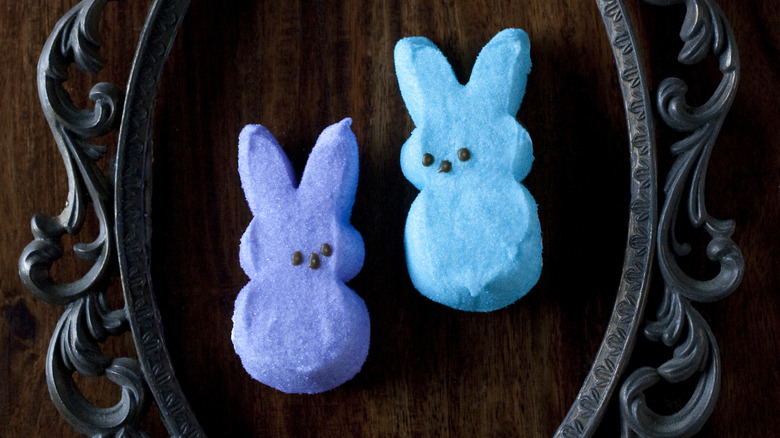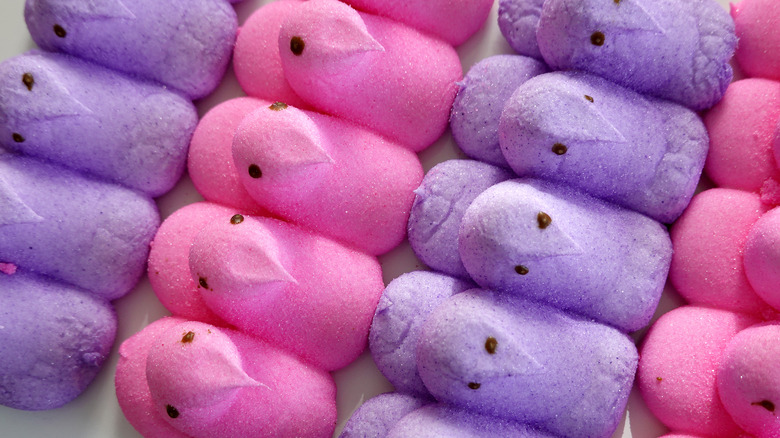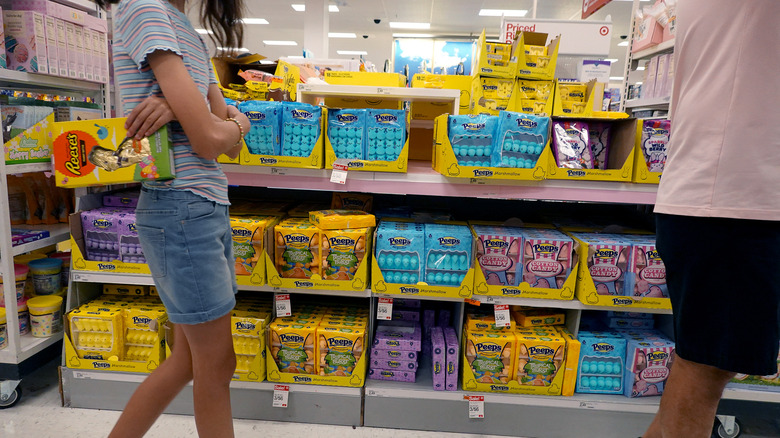The History Behind Peeps
Every Easter, Peeps line grocery store shelves with their dotted, dead-ish eyes looking outward. Ranging in colors from highlighter yellow to Pepto Bismol pink to too-much-chlorine blue, these sugar-covered confections are both loved and hated by people worldwide; there is no in-between. Perhaps you're one of the folks who enjoy them straight out of the package — soft, pliable, and saccharine-sweet. Or, maybe you're one of the people who buys a pack, opens them, then leaves them on the counter for a week or so, until a good, solid crunch becomes part of the overall makeup of these confections.
Peeps likely live in your psyche year-round, particularly come spring. They've been a mainstay of Easter baskets since the 1960s, and they aren't going anywhere anytime soon. But where did these arguably unholy treats get their start? How popular are they? Let's explore the history behind everyone's most loved or hated marshmallow and sugar treat.
Marshmallow animals date back to the 1600s
Peep bunnies and chicks aren't a new invention. In fact, figurines, including animals, made of sugar paste and sweets date back as far as the 1600s. This may come as a bit of a shock, considering the amount of machinery, time, and effort that goes into the creation of some of our favorite candies and confections today. But the simple combination of boiled sugar and white gum, as it was called, has been around for centuries, and has been manipulated into everything from life-size sculptures to simple decor to adorn the table.
Some of the best-known examples of sugar sculptures were on display at a celebration of the marriage of Henry VI of France and his second wife, Maria de Medici, in Florence, Italy. The sculptures varied in size and even included a life-sized replica of the king on his horse — made entirely of the white sugar and gum concoction called sugar paste. Around the same time, cookbooks aimed at housewives included instructions on how to make sugar paste and, additionally, how to create basic sculptures for entertaining purposes — mainly to decorate tables and as an accessory at banquets.
Enter Sam Born and the Just Born company
Let's fast-forward about 300 years from the life-size sugar sculpture creations honoring kings and queens across Europe. Sam Born, a 19-year-old Russian-Jewish immigrant from France, arrived in New York City in 1910. He's already a fountain of knowledge when it comes to confectionary arts including sugars, caramels, and chocolate-making, where he excelled. In 1916, the city of San Francisco honored him — awarding him the keys of the city — for inventing a machine that put the sticks into lollipops (called the Born Sucker machine). This modern-day Willy Wonka also invented a new process for the creation of chocolate sprinkles — or "jimmies" — and for the hardened chocolate shell on the outside of Eskimo pies. Thanks to his prowess in candy and chocolate technology, Born eventually earned himself enough money to open his own candy shop in Brooklyn, New York around 1923.
After several successful years in New York, Sam Born moved the now aptly named Just Born company to Bethlehem, Pennsylvania. There, the company was able to produce more products and, namely, more candy. Just Born also began to acquire other smaller candy companies in the area and became a booming source of employment in a locality that had traditionally relied on steel manufacturing. Some of the better-known companies acquired by Just Born included Mike and Ike Original Fruits in 1940 (yes, those Mike and Ikes) and Hot Tamales in 1950 — another product that's still around today.
Born acquires the Rodda Candy Company
Also operating in Pennsylvania at the time was Rodda Candy Company. Located in Lancaster — not far from Hershey's chocolate operation — Rodda had been in operation since around 1908. The company specialized in jelly beans — another springtime favorite — as well as jelly eggs, sugar-coated almonds, and, apparently, early iterations of Peeps. A catalog of sweets published around 1925 shows a Peeps-like product, which it is believed may have been created for some of Rodda's loyal customers later around 1940. Rodda leaned into the Easter candy business — in addition to making jelly eggs, almonds, and marshmallow animals, it also made candy in the shapes of crosses and other Christian religious iconography.
Despite its popularity in the area, Rodda was embroiled in a legal battle over rights in the early 1930s. In addition to its legal woes, owner and founder Roscoe E. Rodda passed away in 1940, and the Rodda Candy Company was looking to sell. In 1953, Just Born bought Rodda Candy Company and began overhauling several of its more time-consuming and difficult candy-making processes — including that of their marshmallow and sugar animals.
Peeps get automated and lose their wings
The initial way that Peeps were made at the Rodda Candy Company was shockingly labor-intensive and inefficient. As many as 80 confectioners were needed to craft fresh marshmallows — created from a concoction of egg whites and sugar. The mixture was then loaded into steel fluted-tipped pastry bags and each animal was hand-created. Then, the marshmallow mixture was left to air dry. Overall, the process took up to 27 hours, not to mention multiple hands and labor time. The chicks at this time also had hand-piped wings and more defined features, so the extra details added to the time-consuming process. Even the little black dead eyes were placed by hand.
Once Just Born took control of Rodda Candy Company and, consequently, the Peeps-not-yet-called-Peeps operation, the time-consuming process changed significantly. Sam Born's son, Bob Born, who had joined the company back in 1946, built what came to be known as "The Depositor." The machine automated the Peeps process, allowing a series of tubes to deposit six rows of Peeps at a time, instead of waiting for confectioners to painstakingly flute them one by one. So, now, instead of 27 hours, the process of making Peeps took 6 minutes. Because of the machine's design, though, the Peeps lost their wings, sporting a sleeker shape — the one we know and love (or hate) today. Bob earned the moniker "Father of Peeps" for this invention.
Chickens, bunnies, pumpkins, and more adorn grocery shelves
As anyone who's recently perused the aisles of their grocery store — namely the candy aisle — knows, the world of Peeps is no longer dominated by dot-eyed baby chicks. Although the chicks were the original and first Peeps iteration, bunnies were the second, introduced in the 1980s. Nowadays, depending on the season, you can find any number of marshmallow animals and holiday objects lining the shelves. Around Christmas time, you can find snowmen, reindeer, bears, Christmas trees, and gingerbread men on the shelves. For Halloween, Just Born releases pumpkins, sugar skulls, cats, and ghosts — very appropriate for spooky season. Valentine's Day plays host to hearts in a variety of colors, while Easter remains the prime chick and bunny-buying season.
In addition to the variety of seasonal shapes, Just Born has expanded from its simple marshmallow-flavored formula. The holiday-themed shapes come in holiday flavors from peppermint to gingerbread. But there are other off-the-wall flavors like cotton candy, party cake, fruit punch, sour watermelon, and even Dr Pepper. There are also Peeps that are half-dipped in chocolate. The original yellow chicks remain the best sellers regardless of the innovative flavors, colors, and shapes.
What exactly are Peeps made out of?
With all those flavors, colors, and shapes, you may be curious as to what goes into the making of a Peep today. According to the ingredients panel on the average Peeps, these marshmallow confections contain a combination of sugar, corn syrup, gelatin, and less than 0.5% potassium sorbate, natural flavors, colorings, and carnauba wax (for the dead eyes). The ingredients and recipe are virtually unchanged since Peeps' first inception nearly a hundred years ago, save the flavorings added for the more interesting and new flavors.
Nutritionally, each Peep clocks in at around 28 calories with zero grams of fat and very little sodium. Before you get excited about working these into your diet regimen, know that the sugar content is nearly 5 grams per Peep — rather on the high side and no better than any other candy. There are sugar-free varieties made with maltitol and isomalt which arrived on the scene in 2007, too, but we'd rather just stick to the original and break our calorie-counting rules for the day. As a note, too, Peeps are not vegan, due to their containing gelatin, which is derived from animal hooves, bones, and collagen after being boiled down.
Are Peeps indestructible?
It's long been a subject of debate: Just how indestructible are these marshmallow abominations? They seem overly shelf-stable, almost as if they would be able to survive a nuclear war along with Twinkies and powdered Kool-Aid. With that in mind, in 1999, researchers Gary Falcon and James Zimring at Emory University decided to test just how durable Peeps are.
The marshmallow animals were subjected to rigorous — albeit fairly fun-loving — testing. The researchers submerged them in water, acetone, sodium hydroxide, and sulfuric acid. The Peeps survived each test with very little noticeable reaction, save some of the sugar dying of the solvent. What wound up actually destroying a Peep? Phenol, an acidic organic compound, did the trick. So, if you're looking to take out some anger and destroy a box of Peeps, phenol is the answer. That said, microwaves have been known to greatly disfigure and more-or-less destroy the confections, too.
Eating and using Peeps today
Although you may be anti-Peep, you have to admit that these creative little marshmallows do add a touch of whimsy to their respective holiday seasons. And while many folks enjoy eating them fresh out of their packs — or stale out of their packs (raises hand slowly) — they can actually have a place in your marshmallow-laden recipes throughout the year.
At their core, Peeps are just marshmallows coated in sugar. So, working them into dishes and desserts that utilize regular white marshmallows is an easy swap. Take s'mores, for example. There's no reason you can't roast a Peep over the fire, smother it with chocolate, and smoosh it in a graham cracker. Plus, you have the added bonus of potentially setting a Peep on fire. You could also swap them in for marshmallows in classic Rice Krispie treats. We'd recommend sticking with one color so as to not create a tie-dyed mess, but a batch of bright pink or lavender Rice Krispie treats around Easter could become a new Easter tradition. You can also use Peeps to adorn an Easter or springtime cake, pie, or quickbread. Although they may be picked off quickly by Peep-haters, no one can argue about their ability to add a festive and springy touch to a dish.
Peeps contests and competitions abound
In addition to seeing what can destroy a Peep, contests and competitions involving the sugary confections are common. Of course, there is a Peeps-eating contest — not unlike the one depicted on Malcolm in the Middle, where brother Francis is challenged to eat 100 Peeps, referred to on the show as "Quacks." In 2017, Matt Stonie, a professional eater, set the world record for Peep-eating at the 2017 National Harbor World Peeps Eating Championship. The record is 255 Peeps in 5 minutes. We'll let that sit for a minute — take your time. Stonie beat his own record from the previous year, where he ate 200 Peeps in 5 minutes.
Aside from competitions where people gorge themselves on Peeps, there are structural contests utilizing these practically indestructible sweets, too. In 2006, The Washington Post launched a "Peep Show" — an annual diorama contest where Peeps must be used in a 3D scene. Past winners included re-imaginings of Van Gogh scenes, historic battles, and movie scenes. The contest ended in 2017, but Peep (and diorama) aficionados have kept the tradition going. Then, in 2021, The Washington Post resurrected the contest, with the only difference being that participants needed to submit their creations via pictures, and the entries would be shown on TikTok. Entries are judged on theme, originality, eat-ability, showmanship, and craftsmanship.
Peeps are still loved (and hated) today
With more than 2 billion Peeps created every year (you could literally circle the Earth twice with them), you'd think they'd be less divisive than they actually are. In fact, according to a 2022 survey, more than 65% of Americans will have had a Peep before their 9th birthday. That's likely why they've stayed the number one non-chocolate Easter treat for more than 20 years, too. But hatred for them abounds — with plenty of Facebook groups dedicated to bashing the fluffy treats. According to a recent survey, 25% of Americans said they loved Peeps, while 16% said they vehemently hated them. Everyone else fell somewhere in the middle.
But why do people hate them so much? The texture is off-putting for many; it's the combination of a crunchy sugar exterior and a gooey, gelatinous interior. Another reason is that they're overloaded in terms of sugar. A marshmallow is basically just sugar and egg whites, and with Peeps, there's even more sugar on top. It's too much for some. And perhaps the simplest reason is that many people simply don't like the way they taste. The argument is compounded by the fact that many folks prefer them after they've gone stale which — usually — is not the hallmark of a good eat.
Peeps live rent-free in our brains
Whether you love them, hate them, or like to build extensive dioramas with them, Peeps are here to stay and have earned a permanent place in our psyche (and on our store shelves). Although creating customizable Peeps has gone the way of the dinosaur (and the official Peeps web store has closed), there are still so many combinations present just on store shelves that you can basically choose your perfect shape, flavor, and garnish (yes, some are chocolate-dipped) just by shopping around.
Bethlehem, Pennsylvania, remains Peep Mecca, with a Peep-drop each New Year's Eve — although a separate Peeps store opened in 2009 in National Harbor, Maryland. The Just Born factory in Bethlehem does not offer tours, although videos of the candy-making process are easily accessible online. After appearances on morning programs including "Good Morning America" and "The Today Show," spots on everything from "The Daily Show" to "Jeopardy!" to "South Park," and celebrity fans including Justin Bieber and Joe Jonas, Peeps aren't going anywhere anytime soon.
